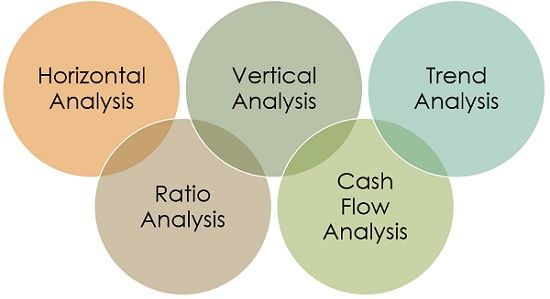Definition: Financial Analysis, as the name itself signifies, is a process of critically studying, reviewing and interpreting the information provided in the company’s financial statements so as to understand the same and take better decisions regarding the firm’s operations.
Financial Analysis is used to evaluate the present and past financial position of the enterprise along with the results of the operations, so as to ascertain the optimum estimates and forecast future conditions.
Sources of Financial Data Analysis
There are a number of sources of financial data analysis which are given hereunder:
- Financial Statements
- Notes to Accounts
- Statement of Equity
- Statement of Cashflows
- Annual Reports
- Interim Financial Statements
- Business Periodicals
Financial Analysis is not only concerned with analysis, i.e. elucidation of the financial information by using various accounting techniques, rather it also includes interpretation of the information given in the statements by clarifying the details and its relevance. In short, it is the analysis and interpretation of financial data.
Importance of Financial Analysis
- It helps in measuring the profitability of the business enterprise.
- It suggests the trends and behaviour of various items.
- It ascertains the growth prospects of the firm.
- It compares the financial position of the concern with that of the other firms operating in the industry.
- It assesses the long term solvency of the company.
- It gauges the company’s performance over the years.
- It helps in determining the operational efficiency, so as to make rational decisions.
- It analyses the financial stability and liquidity position of the business.
The main aim of financial analysis is to identify the relationship between different items of the financial statements and interpreting them so as to obtain an insight into the company’s earning and operational efficiency, which in turn helps to ascertain its financial health.
Tools of Financial Analysis
There are various tools that facilitate financial analysis of the data, described as under:

- Horizontal Analysis: Horizontal Analysis is performed with the help of comparative financial statement which shows the trend and direction of the company’s position.Comparative statements often disclose the firm’s financial position and its profitability for different financial years, side by side, to give an insight into the overall improvement or decline in the position of the enterprise. To do so, the company’s balance sheet and income statement are prepared in comparative form.
It should be kept in mind that one can compare the financial data of the firm only when the accounting principles are the same.
- Vertical Analysis: Vertical Analysis is conducted using common-size statements, which are used for both inter-firm and intra-firm comparison for a particular financial year or for multiple financial years.Common Size statements, or otherwise called as a component percentage statement, shows the relationship between various items of the balance sheet or income statement, with a common item, such as total assets, total liabilities or net sales.
In these statements, each item is expressed in the form of a percentage of the common item and the common item is taken as 100. In this way, it can be easy to compare the percentages of the previous years with that of the current year, as well as the corresponding percentages in the financial statements of peers.
- Trend Analysis: In trend analysis, the operational results and financial position of the firm are analysed, over a number of years. It determines the behaviour of a particular item of the financial statement, over a particular period.In this tool, we use past financial data of a firm, so as to observe the percentage change in the particular year’s data. It has a critical role to play, in the sense that it highlights changes in the nature of the business, over time.
- Ratio analysis: Ratio refers to the mathematical expression, showing the relativeness of one accounting figure with that of another.In ratio analysis, the comparison is made between the current year and previous years ratios, as well as between different companies operating in the industry.
It relies on the principle that a particular accounting figure, is not enough to convey material information, however, if we express it in the form of a ratio, they certainly communicate relevant information which is useful to the management of the enterprise.
- Cash Flow Analysis: Cash Flow Analysis as the name suggest is the flow of cash into and out of the business. For this purpose, the cash flow statement is prepared which keeps a track of cash inflows and cash outflows, during a particular financial year.Hence, it helps to gauge the changes in the company’s cash position between two balance sheet dates.
The financial data analysis is very useful because of the interest of the stakeholders, i.e. suppliers, creditors, employees, tax authorities, investors, management, government agencies etc. in the financial results of the firm.

Leave a Reply